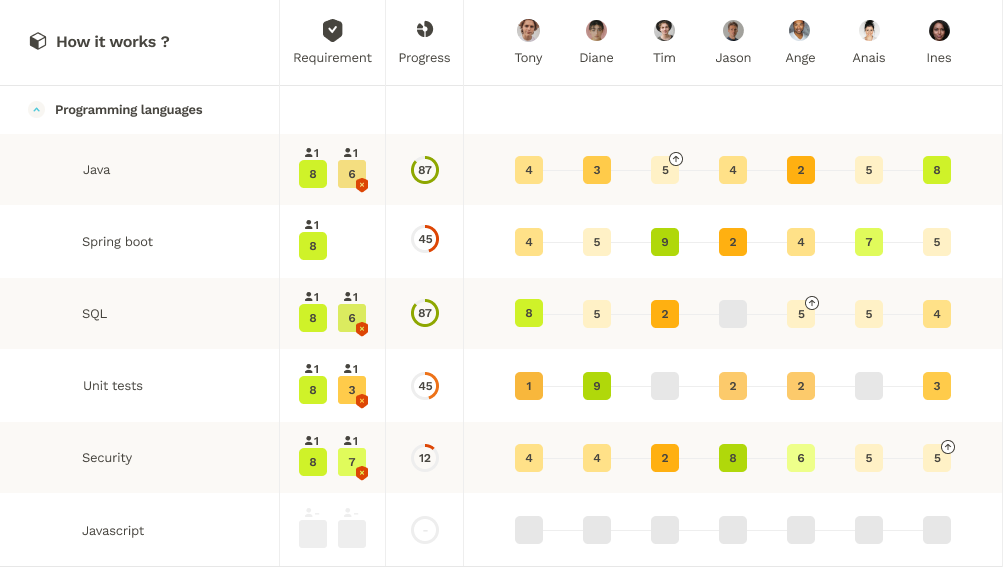Introduction
Is your human resources department keeping up with your company’s need for skilled people ? The skill matrix is the perfect tool for human resource managers to support the skill development in the organization. This powerful resource enables companies to strategically assess, develop, and utilize their workforce’s skills, leading to improved performance, employee engagement, and success. In this article, we will delve into the concept of a Skills Matrix and explore how it can revolutionize your HR practices.
Understanding the Skills Matrix
Skills Management was introduced by the HR of IBM at a large scale in 2003 and was a tremendous success. The Skills Matrix is a visual representation of the skills and competencies possessed by individuals within an organization. It provides an overview of the skills’ distribution across teams or departments, highlighting both strengths and areas for improvement. By mapping out employee skills in a structured manner, HR professionals gain insights into the collective skill set of the workforce, facilitating better decision-making, talent management, and resource allocation.

Benefits of skill-based talent development
Enhanced Workforce Planning
The Skills Matrix enables HR teams to identify skills gaps and make informed decisions regarding training, hiring, or reallocating resources. It ensures that the right individuals are assigned to projects or roles that align with their skill sets, optimizing productivity and minimizing potential bottlenecks.
Targeted Training and Development
With a Skills Matrix, HR can identify specific skills that need improvement or further development within the organization. This information allows for the implementation of targeted training programs that address the identified gaps, fostering professional growth and increasing overall competency levels.
Succession Planning
By having a clear overview of the skills possessed by employees, HR can proactively plan for future talent needs and succession planning. The Skills Matrix helps identify potential successors for critical roles within the organization, minimizing disruption during periods of transition or unexpected vacancies.
Increased Employee Engagement
Employees appreciate when their skills and contributions are recognized and utilized effectively. A Skills Matrix facilitates transparent communication between HR and employees, allowing individuals to see how their skills align with organizational objectives. This visibility not only motivates employees but also encourages collaboration and a sense of ownership within the workforce.
Key success factors for skill development in your organization
Top-down and bottom-up approach
Like many changes in the company, a successful skill management process is based on a mix between top-down and bottom-up approach.
The top-down approach is required to identify strategic skills needed for the business. The management defines strategic goals, from which are derived the required skills as well as the number of required people. The information is required in the recruiting process to hire the best profiles for the future development of the company.
The teams in contact with the customers are the best placed to identify the skills they need and would like to develop. The aggregated requirements gathered from the teams will help the management to identify the key skills to be developed. With this information, the HR department can be better to adapt the training offer to meet these requirements.
Clear benefits for the employees
A skill management can be only can be only successful if employees are willing to assess their skill and give feedback. It works only if they see a clear benefit of the skill management in their daily work.
The first benefit of skill management is the individual skill development plan. Each employee knows his strengths and which skill he has to develop to be successful in his career.
With their skill profile, employees can receive interesting training offers, support from colleagues or internal job opportunities matching their skills.
Self-assessment and external feedback
Relying only on assessment of skills by a manager in a skill matrix is not effective. The best assessment and feedback comes from experts, as they know the best what is expected for a given skill.
Asking the employee to first assess his skill level makes him more responsible for his development and will generate more intrinsic motivation to learn for the given skill. Request experts in the team to give personal feedback and advice on how to increase the skills.
Collaborative work for maintaining the skill catalog
The skill catalog is like a common language in your organization to define skills. It can be a tough work for the HR department to maintain a good quality of a centralized skill definition and skill levels.
Some software providers propose skill catalogs for different industries. Even if they are regularly updated, it is very probable that these catalogs won’t contain skills about internal tools and specific business. So it is important that experts of your company have the opportunity to directly add or update skills in the catalog.
Automation
Managers has often other priorities than reminding employees to update their skill data. A software can automate many tasks related to skill management:
- Reminding employees to update their skill profile or to warn about risks due to missing skills.
- Reminding employees to renew certifications.
- Inform employees about new trainings about the skills that they would like to develop.
- Warn team members about risks to missing skills in their team.
Conclusion
We have observed that the key success factor for skill development is the employee empowerment, the collaborative work and automatic guidance of employees.
If you are looking for an innovative software solution to support the development of skills in your organization, we invite you to look at our Skill Matrix Software.
The Skill Management Software in Teammeter supports people development with intelligent functions so that the HR department and managers can develop skills in the whole organization.

